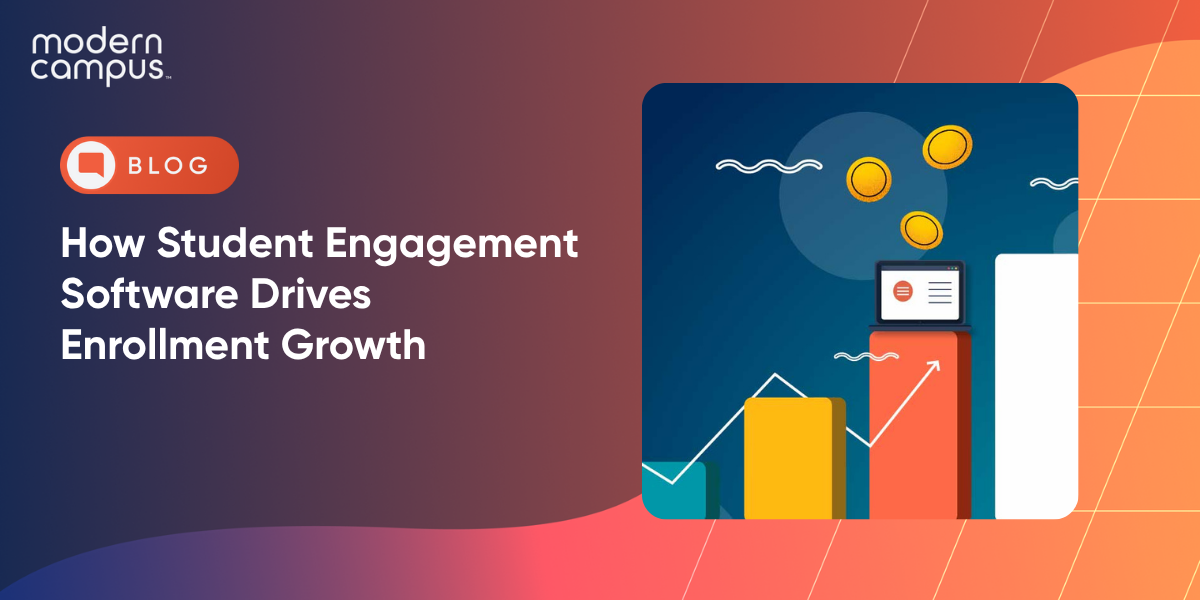How Student Engagement Software Drives Enrollment Growth
Declining enrollments and rising student debt pose significant challenges to higher education. Institutions must adopt innovative strategies to attract prospective students. A well-executed marketing plan is essential. But without the right tools, even the best efforts can fall short.
Student engagement software is transforming enrollment marketing by enabling institutions to connect with students in more personalized and impactful ways. By leveraging technology, colleges and universities can create seamless, data-driven experiences that resonate with prospective students and increase enrollment.
This blog explores the secrets to an effective enrollment marketing strategy, from defining target audiences and strengthening brand identity to utilizing omnichannel outreach. We'll discuss crafting engaging content, personalizing communication, harnessing data-driven insights and embracing student engagement platforms to drive results.
How Student Engagement Software Transforms Enrollment Marketing
Emphasizing proactive efforts to attract students, enrollment marketing—also known as admissions marketing—centers on the art of strategically crafting and implementing marketing strategies to increase student enrollment.
This multifaceted approach encompasses crafting compelling messages that resonate with prospective students, utilizing digital platforms to broaden outreach and employing targeted strategies to attract qualified applicants. By leveraging data-driven tactics and understanding demographic trends, institutions aim to enhance visibility, highlight unique offerings and achieve enrollment growth.
This process goes beyond numbers; it's about effectively communicating an institution's distinctive value and cultivating connections that inspire students to choose a school for their educational journey.
Designing a Data-Driven Marketing Plan to Increase Student Enrollment
A successful enrollment marketing plan goes beyond traditional outreach, requiring a data-driven approach that prioritizes student engagement at every stage. By leveraging technology and analytics, institutions can gain deeper insights into prospective students’ needs, personalize their messaging and create a seamless journey from awareness to enrollment.

Let's explore essential strategies for designing a marketing plan that not only attracts students but also fosters long-term engagement and success.
1. Identify and Engage Students with Targeted Outreach
Reaching the right students with the right message is the foundation of any successful enrollment strategy. Traditional outreach methods alone are no longer enough. Institutions must take a data-driven approach, using student engagement software to better understand their audience and create personalized, impactful interactions.
Through technology, colleges and universities can analyze key demographics, track engagement patterns and identify prospective students who are most likely to enroll. Student affairs teams can then proactively engage and support them throughout the admissions process. Advanced analytics provide insights into student interests, behaviors and aspirations, allowing institutions to craft marketing messages that truly resonate.
With the right platform, institutions can automate outreach, segment communications based on student preferences and deliver personalized content through email, social media and digital campaigns. You can increase visibility and foster a more connected campus experience—helping students see themselves as part of the community before they even apply.
Integrating student engagement software into the marketing strategy allows institutions to move beyond broad, generic messaging and create tailored experiences that drive meaningful connections, boost student engagement and increase enrollment.
2. Build a Strong Brand to Boost Student Engagement
A strong brand identity is the foundation of how prospective students perceive your institution. Creating a compelling and connected campus experience is key to standing out and increasing student enrollment.
Define What Makes Your Institution Unique
To capture students’ attention, institutions must highlight their unique strengths–from academic programs and career pathways to campus life, student involvement and co-curricular opportunities. A clear, authentic message that reflects what makes your campus special helps foster trust and credibility.
Use Student Engagement Platforms to Strengthen Your Brand
Student engagement software enables institutions to enhance their brand presence by delivering personalized, interactive experiences across multiple channels. With the right tools, you can:
- Customize content for different student segments, ensuring messaging resonates with their interests and goals.
- Automate and streamline communication to provide timely updates on programs, events and opportunities.
- Use data-driven insights to refine marketing efforts, track student progress and adjust strategies in real time.
Create a Consistent and Engaging Digital Presence
A strong brand identity requires consistency across your website, social media, email campaigns and digital experiences. Institutions that leverage engagement platforms can offer seamless navigation, interactive content and virtual tours—helping prospective students visualize themselves as part of the campus community.
By combining a clear brand strategy with modern software, institutions can cultivate lasting connections, increase student engagement and guide students toward enrollment with confidence.
3. Enhance Outreach with a Connected Campus Experience
Prospective students expect a seamless, personalized experience across multiple touchpoints. A connected campus experience ensures that every interaction—whether on a website, social media or in-person event—feels cohesive, engaging and tailored to their needs.

Leverage Student Engagement Platforms for Seamless Communication
To reach students where they are, institutions must integrate multiple communication channels, including:
- A dynamic, user-friendly website that offers essential information and personalized content.
- Automated email and SMS campaigns that keep students informed about programs, deadlines and events.
- Interactive social media engagement that fosters real-time connections and showcases student life.
- Virtual and in-person events that provide immersive experiences, from campus tours to live Q&A sessions.
With student engagement software, institutions can streamline these efforts, ensuring that prospective students receive consistent messaging and a unified experience, no matter where they interact with the institution.
Create a Data-Driven, Omnichannel Strategy
An omnichannel approach maximizes visibility by integrating data-driven insights into outreach efforts. By analyzing engagement metrics, institutions can identify which channels are most effective, personalize communications based on student behavior and optimize marketing strategies for better results.
By embracing technology and fostering a connected campus experience, institutions can expand their reach and boost student engagement, making it easier for prospective students to find, connect with and choose their school.
4. Create Engaging Content to Increase Student Participation
Content remains a pivotal tool for capturing attention and fostering connections with prospective students. A robust content strategy highlights the value of academic programs while showcasing campus life, student culture and support services, thereby enhancing the overall student experience.
Develop a Comprehensive Content Strategy
To effectively engage your audience, regularly publish diverse content such as blog posts, articles and videos that provide valuable information to prospective students. Address common concerns, including the admissions process, application deadlines and career opportunities. This approach attracts potential students and establishes your institution as an authority in higher education.
Leverage Student Engagement Software for Content Management
Implementing student engagement platforms can streamline the content creation and distribution process. These tools enable institutions to manage content efficiently, ensuring that information is current, relevant and accessible. Utilizing such platforms allows you to tailor content to specific student segments, enhancing personalization and engagement.
Case Study: Enhancing Engagement Through a Well-Managed Website and Blog
Consider success stories like the example of a health sciences university that faced challenges with an outdated website comprising over 8,000 unorganized pages. By adopting a robust content management system (CMS), they successfully migrated existing content and established a dynamic platform for fresh content distribution. This transformation allowed multiple departments to publish informative, targeted and SEO-optimized blog posts, significantly increasing organic traffic and engagement.
By embracing a strategic content approach and leveraging comprehensive platforms, institutions can create meaningful interactions that resonate with prospective students, ultimately boosting participation and enrollment.
5. Personalized Engagement: The Key to Student Success
Today’s students want tailored experiences that make them feel seen, valued and connected to their future institution. Modern engagement software can connect students through personalized interactions that guide them through their enrollment journey and beyond.

Deliver Tailored Communication with Data-Driven Insights
A one-size-fits-all approach no longer works in higher education marketing. By leveraging data-driven insights, institutions can segment their audience based on academic interests, geographical location and stage in the admissions process, ensuring each prospective student receives relevant and timely information.
Create a Connected Campus Experience with Student Engagement Platforms
Personalization is about fostering a connected campus experience where students feel engaged from their first interaction. With student engagement platforms, institutions and their student affairs departments can:
- Provide interactive digital experiences, such as AI-powered chatbots and virtual advisors.
- Offer real-time support and guidance, helping students navigate the admissions process.
- Use predictive analytics to identify students who may need additional engagement to stay on track.
These personalized engagement strategies powered by software solutions allow institutions to create deeper connections, boost student retention and increase the likelihood of enrollment and long-term student success.
6. Use Data-Driven Insights to Optimize Enrollment Marketing
Data analytics uncovering actionable insights that drive smarter marketing decisions. By leveraging software, institutions can go beyond basic metrics and gain a real-time understanding of student behaviors, interests and decision-making patterns.
With predictive analytics, schools can anticipate enrollment trends, identify at-risk prospects and personalize outreach to maximize impact while aligning their messaging with learning outcomes that matter most to prospective students. A/B testing on marketing campaigns helps refine messaging, while heatmaps and engagement tracking reveal how prospective students interact with digital content.
By continuously analyzing and optimizing marketing efforts, institutions can allocate resources effectively, enhance student engagement and ensure every interaction moves students closer to enrollment—all while improving return on investment.
Student Engagement Platforms: The Future of Higher Ed Marketing
Higher education marketing is evolving, and institutions that embrace student engagement platforms are gaining a competitive edge. Through personalized communication, data-driven insights and omnichannel outreach, colleges and universities can create meaningful connections with prospective students—ultimately leading to higher enrollment, increased student retention and long-term engagement.
Traditional marketing efforts alone are no longer enough. College students expect seamless, interactive and personalized experiences at every touchpoint. Institutions that utilize technology to enhance outreach, build strong brand identities and optimize engagement are better positioned to attract and retain students.
At Modern Campus, we specialize in student-first technology solutions designed to transform the way institutions connect with learners. Our AI-driven student engagement software, personalized marketing automation and dynamic web experiences empower colleges and universities to meet students where they are, guiding them from first interaction to enrollment—and beyond. Request a demo today and discover how our innovative solutions can drive your success.
Last updated: March 17, 2025



